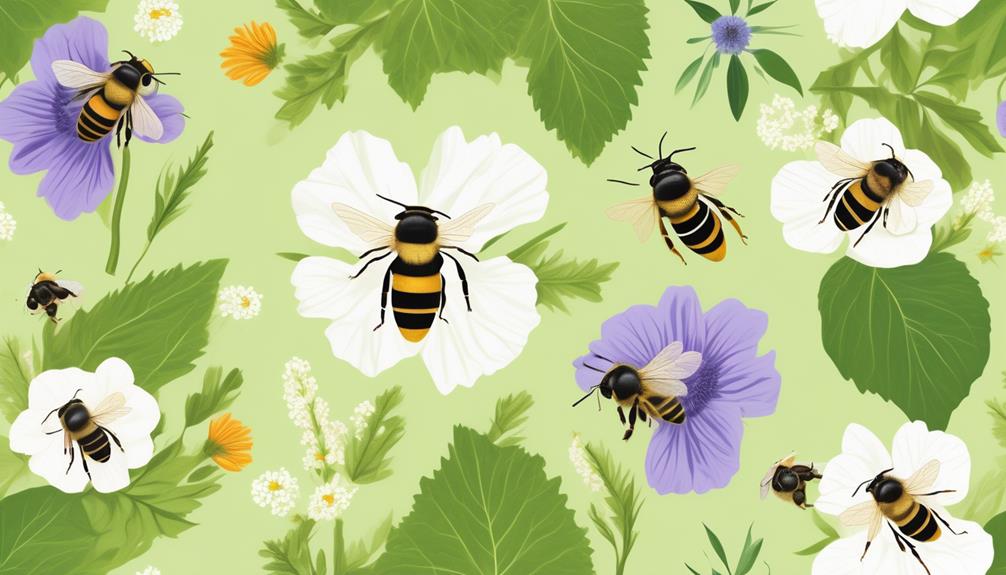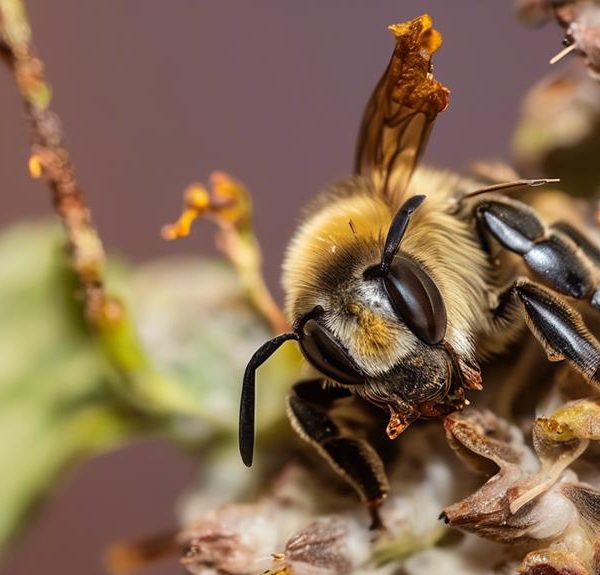Hop on a journey to uncover the exotic origins of the industrious leaf cutter bees; a tale of migration, adaptation, and survival.

Where Are Leaf Cutter Bees Native to?
Just as a map is a symbol of a traveler's journey, the leaf cutter bee, with its unique behavior and habitat preferences, represents a fascinating journey through the natural world.
You've likely seen these industrious creatures, perhaps without even realizing it, as they diligently cut precise circles and ovals from leaves. But have you ever stopped to wonder where they originally hail from?
While we'll explore the global distribution of these intriguing insects in detail, let's begin with this: their origins trace back to more exotic locales than their current widespread distribution might suggest.
Curious? Let's unveil the mystery together.
Key Takeaways
- Leaf Cutter Bees are native to North and Central America.
- They have evolved sharp, serrated mandibles for precise leaf cutting.
- Leaf Cutter Bees are found in areas with abundant vegetation in North America.
- Leaf Cutter Bees, particularly Megachile centuncularis and M. versicolor, flourish in Europe.
Understanding Leaf Cutter Bees

What exactly are Leaf Cutter Bees, you might wonder? They aren't your typical honeybees or bumblebees. In fact, they're a bit of an anomaly in the bee world. Belonging to the genus Megachile, Leaf Cutter Bees are solitary creatures that don't live in hives, but make their nests in various crevices or in the ground.
But what makes them truly fascinating is their unique nesting behavior. You see, these bees don't gather pollen on their legs like most bees. Instead, they carry it on their bellies. Females cut neat circles or ovals out of leaves and use these leaf fragments to construct perfectly cylindrical cells inside their nests. Each cell is filled with a mixture of nectar and pollen, on which she lays an egg. The leaf fragments act as a protective barrier for the developing larvae.
They're an essential part of our ecosystem, serving as critical pollinators for many wildflowers and crops. So, while they mightn't produce honey for us to enjoy, they're still incredibly valuable to our environment. Understanding Leaf Cutter Bees gives us a glimpse into the diverse and complex world of insects.
Origins of Leaf Cutter Bees

Having grasped the intriguing lifestyle of these solitary insects, let's now explore the genesis of Leaf Cutter Bees, tracing their evolution and geographical spread.
The Leaf Cutter Bees, scientifically known as Megachilidae, are native to North and Central America. Their evolution dates back to the Eocene epoch, approximately 34 to 56 million years ago, coinciding with the diversification of flowering plants.
Over time, Leaf Cutter Bees have adapted to various environments, from the subtropical regions of Mexico to the temperate climatic conditions of North America. Their strong flight capabilities have enabled them to spread across diverse geographical terrains. However, they're more prevalent in areas with abundant vegetation, as leaves are essential for their nesting behavior.
Their adaptive nature and resilience have contributed significantly to their survival and proliferation. These bees have also witnessed morphological changes over the years, with the evolution of sharp, serrated mandibles that facilitate precise leaf cutting.
Understanding their origins and adaptations offers valuable insights into their role in our ecosystem, particularly their contribution to pollination and plant propagation. You'll find this knowledge not just intriguing, but also essential in appreciating these industrious insects.
Leaf Cutter Bees in North America

Diving into the world of Leaf Cutter Bees in North America, you'll find that these nimble insects have carved out a significant ecological niche, playing an instrumental role in the region's pollination dynamics. They've been hard at work, seamlessly integrating into various ecosystems across the continent.
In North America, Leaf Cutter Bees are predominantly found in areas with abundant vegetation, flourishing in both urban and rural settings due to their adaptability. They're not picky about their nesting sites, often choosing hollow plant stems or decomposing wood.
The females, known for their industrious nature, craft intricate nests, utilizing their mandibles to cut precise leaf fragments. These fragments are then transported back to the nest and meticulously arranged, forming a protective shell for their offspring.
Furthermore, these bees are solitary, meaning each female takes care of her own brood. This distinction sets them apart from many bee species, which are typically social.
Their contribution to pollination is essential, as they help maintain plant diversity and productivity. They're crucial to the survival of various flowering plants, transferring pollen as they collect nectar and leaf material. This symbiotic relationship benefits both the bees and the plants, ensuring a healthy, thriving ecosystem.
Leaf Cutter Bees in Europe

Shifting our focus across the Atlantic to Europe, you'll find that Leaf Cutter Bees also play a vital role in the continent's diverse ecosystems, adapting to a range of environments and contributing significantly to plant pollination. These bees, particularly the species Megachile centuncularis and M. versicolor, flourish extensively in Europe.
Their adaptability is remarkable. They inhabit various climates, from the Mediterranean regions to the cooler climes of Northern Europe. You'll often find them in gardens, meadows, and woodlands. What distinguishes them from other bees is their unique method of creating nests. They meticulously cut out leaf sections, using them as building materials for brood cells.
Their contribution to plant pollination is noteworthy. You'll observe that Leaf Cutter Bees don't exhibit flower fidelity, an attribute that enhances cross-pollination. Unlike honey bees, they carry pollen on their abdomen, which brushes off easily when they visit different flowers. This method of pollen transfer is highly efficient, increasing genetic diversity among plants.
Despite their importance, Leaf Cutter Bees, like many other pollinators, face threats from habitat loss, pesticides, and climate change. It's crucial that we continue to study their habits and habitats to ensure their survival and the ongoing health of Europe's ecosystems.
Leaf Cutter Bees in Asia

Venturing to Asia, you'll find that Leaf Cutter Bees, specifically the species Megachile nipponica and M. tokioana, are integral to the continent's diverse ecosystems, demonstrating impressive adaptability and playing a pivotal role in plant pollination. These industrious insects, with their distinctive mandibles, exhibit a fascinating behavior: they meticulously cut out leaf fragments, which they use to construct their nests.
- nipponica and M. tokioana, both endemic to Asia, contribute significantly to the pollination of various plants, thereby maintaining biodiversity. However, it's their unique nesting behavior that truly sets them apart. By observing these bees, researchers have noted that they select certain plant species for nest construction, demonstrating a level of discernment and knowledge about their environment that's remarkable in the insect world.
In their choice of nesting sites, they show distinct preferences, often choosing cavities within dead wood or hollow stems, which they then line with leaf fragments. This not only ensures the protection of their offspring but also contributes to the decomposition process, thus playing a role in nutrient cycling within the ecosystem. Despite their size, Leaf Cutter Bees in Asia make a significant impact on their environment.
Conclusion
So, you've journeyed with leaf cutter bees from their origins to their current habitats across North America, Europe, and Asia. These fascinating creatures, native to North America, have adapted to thrive in various environments.
Their unique leaf-cutting behavior and significant role in pollination underline their importance in our ecosystem. It's a testament to nature's resilience and adaptability, reminding us of the biodiversity that enriches our planet.



